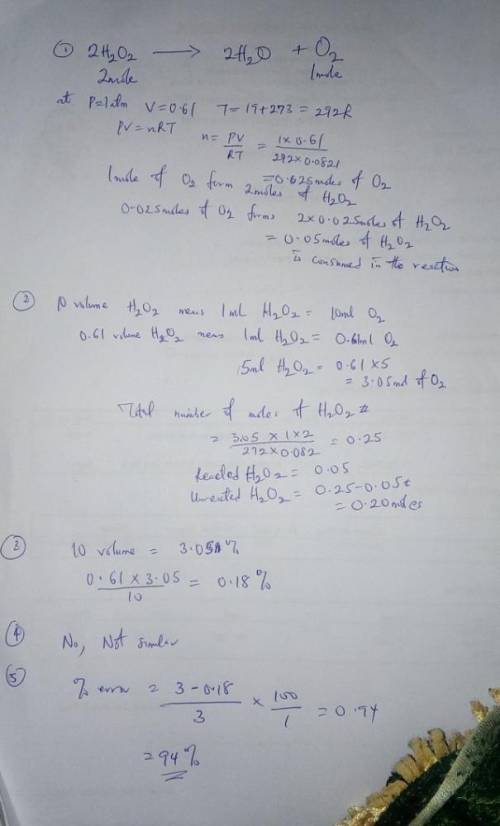
Chemistry, 17.07.2020 05:01, jones501324
1. Calculate the number of moles of O2 produced using the ideal gas law. Then, use this value to calculate the number of moles of hydrogen peroxide you began the experiment with. HINT: Use the balanced equation provided in the lab introduction. 2. Calculate the number of moles of hydrogen peroxide you would have if you used 5 mL of a pure hydrogen peroxide solution. HINT: The density of hydrogen peroxide is 1.02 g/mL. 3. Determine the percentage of hydrogen peroxide in your solution. 1.02 g/mL * 5 mL = 5.1g / 34 g = 0.15 mol 4. Was the calculated percentage of hydrogen peroxide close to the same as the percentage on the label (3%)? Calculate percent error of your value.

Answers: 2
Other questions on the subject: Chemistry

Chemistry, 22.06.2019 08:30, lpssprinklezlps
What method(s) do plants use to obtain nitrogen? select all that apply. absorb it from the atmosphere use bacteria to convert nitrogen to usable form obtain usable nitrogen compounds from the soil absorb nitrogen from water taken in at the roots
Answers: 3

Chemistry, 22.06.2019 10:40, justicejesusfreak
Which buffer would be better able to hold a steady ph on the addition of strong acid, buffer 1 or buffer 2? explain. buffer 1: a solution containing 0.10 m nh4cl and 1 m nh3. buffer 2: a solution containing 1 m nh4cl and 0.10 m nh3
Answers: 1

Chemistry, 22.06.2019 20:00, Isaiahtate053
The volume of a single vanadium atom is 9.29×10-24 cm3. what is the volume of a vanadium atom in microliters?
Answers: 3
Do you know the correct answer?
1. Calculate the number of moles of O2 produced using the ideal gas law. Then, use this value to cal...
Questions in other subjects:



Law, 09.12.2020 19:40

Computers and Technology, 09.12.2020 19:40


Mathematics, 09.12.2020 19:40

Mathematics, 09.12.2020 19:40

Mathematics, 09.12.2020 19:40


English, 09.12.2020 19:40







